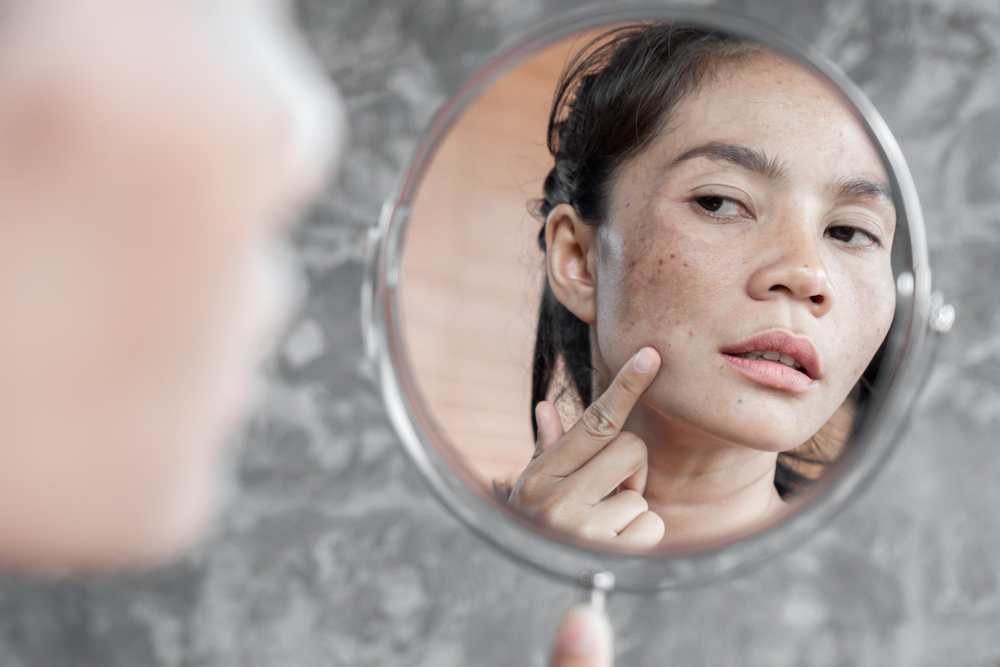What Are Sun Spots?

The summer is right around the corner, and that means we will be spending more and more time outdoors. But fun in the sun can lead to sunburn and other unwanted skin conditions, including sun spots. Most people who have any prolonged exposure to the sun will develop sun spots, some people as early as their 20s or 30s. While sun spots are not uncommon, you should take note of any changes in your skin so you can detect precancerous spots early.
If you’ve noticed flat, brown spots on your face, hands or chest, you may have a sun spot caused by exposure to the sun. In this article, we will learn more about sun spots, how they are caused and your best treatment and prevention options.
What are Sun Spots?
A sun spot is a darkened area of the skin that is caused by exposure to the sun. It typically appears as a brown spot and is flat to the touch. Sun spots are generally nothing to worry about, as they are typically benign and noncancerous. Most patients seek treatment for sun spots because they dislike the appearance of their skin, especially those that appear on the face, hands or chest.
Sun spots are most commonly found on the areas of the body that receive the most exposure to the sun. They can become darker as sun exposure continues. Sun spots are extremely common, especially among people with fair skin or those who do not protect their skin with sunscreen or other UV prevention products.
How are Sun Spots Formed?
When your skin is exposed to the sun, melanocytes, or the pigment-producing cells in the skin, produce excess melanin. Because melanin is a pigment, it results in the appearance of a dark spot.
Are Sun Spots Dangerous?
A typical sun spot is not considered dangerous. However, it does mean that your skin has had excessive exposure to sun which can indicate the potential for other sun-related issues. Sun spots usually indicate an increased production of melanin, rather than an increased production of melanocyte cells. Abnormal moles and melanoma are typically accompanied by an increase in the production of melanocytes cells that have the potential to be cancerous.
In any case, it is recommended that you seek guidance from a dermatologist anytime you see a noticeable skin change such as the appearance of a new dark spot or mole. Your dermatologist may choose to perform a biopsy to determine if the spot is cancerous and if it must be removed and treated.
Are Sun Spots the Same as Moles?
Many people have difficulty determining if a spot is a sun spot or a mole. Sun spots appear due to an increase in pigment, whereas moles develop as a result of an increase in melanocyte cells. For someone without dermatological training, it can be difficult to tell the difference between the two. That is why it is critical that you receive an annual skin check and to bring any changes or abnormalities to the attention of your dermatologist right away. Your doctor will be able to identify whether the spot is a mole or a sun spot and can provide you with the best guidance on treatment and prevention.
Sun Spot Treatment and Prevention
You are constantly exposed to the sun, even when you are indoors. It can be challenging to avoid all exposure to UV rays. However, there are some things you can do to prevent overexposure to the sun and reduce your risk of developing sun spots.
Prevention of sun spots will include a multi-pronged approach. It is recommended that you wear sunscreen daily on all areas of your skin that are exposed to the sun. When you are outdoors, wear a wide-brimmed hat and a long-sleeved shirt or pants to protect your skin. Try to avoid lengthy exposure to the sun by periodically seeking shade or going indoors.
Treatment of existing sun spots should be done under the direction of your dermatologist. There are a variety of over-the-counter treatments as well as in-office treatments they can be effective at fading dark spots. In general, fading a sun spot takes time and often multiple treatments for noticeable changes to occur. And even with treatment, continued sun exposure can result in more sun spots to develop.
Products containing skin lighteners such as hydroquinone can be obtained over-the-counter. Your dermatologist may prescribe topical treatments that include vitamin A derivatives that can be helpful in fading dark spots. Your dermatologist will be able to assess your specific skin condition and provide you with an effective treatment plan.
Buckhead Dermatology Sun Spot Treatment Atlanta
If you believe you have sun spots on your skin, contact Buckhead Dermatology today to schedule a consultation with Dr. Straughn. Our doctor can help you identify areas of concern and provide you with an effective treatment plan that takes your unique skin into consideration.
